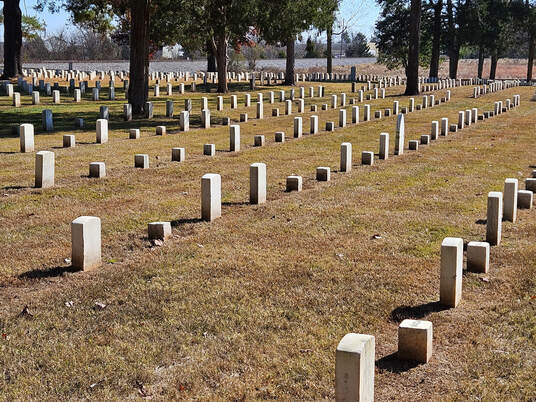
Identifying the Unknowns
DNA
In this modern age, we are used to seeing crime shows where bodies are identified in minutes using DNA evidence.In reality, DNA analysis takes a long time to get the results and then you need something to match it against. The search could be narrowed down if you had a child or sibling as a match but even then, it may not be a definite determination.
Now take that back to trying to identify a Civil War era body. First, a body needs to be exhumed to try to take a DNA sample. How do you determine which of the thousands of unknown graves to study. Plus, the odds of finding a viable sample over 150 years later are not good. The sample will then need a match to a descendant. Even if a researcher can find a potential descendant, the number of generations will greatly decrease the amount of matching DNA strands.It is highly unlikely to come to a definite conclusion that a specific ancestor is the body in that specific grave.
The Department of Defense is doing DNA matching in trying to locate missing in action and identifying recovered bodies. They can secure possible DNA matches from a child or grandchild increasing the amount of DNA strands to compare. The DOD also realizes the large cost involved in conducting DNA analysis. That is why the current DOD policy restricts DNA analysis to only unknown soldiers from World War II and later.
Due to all these reasons, using DNA to identify a Civil War unknown burial is not a viable option.
Narrowing the Range of Possibilities
During my “Where Did They Die” study of Stones River National Cemetery, it became apparent that burials were done based on where the bodies were originally buried. This was especially true of battlefield burials. By looking at the known graves, it lent considerable credence that the unknown burials surrounded by known burials must have also died in the same battlefield location. If so, then these unknown soldiers also belonged to the same brigades as their fallen comrades.
As a result, if a descendant comes to the Visitor Center looking for an ancestor who died the day of the battle and the soldier is buried somewhere in an unknown grave, we may be able to narrow down the possible grave sites to a small section of graves if we know the brigade of the soldier. Instead of looking at over two thousand unknown graves, we may be able to limit their viewing to a small part of a section.
Eliminating All but One Possibility
Actor Matthew Broderick was on a televised genealogy show retracing a branch of his family tree. His search led to Atlanta where one of his ancestors fought during the battle along one of the railroad lines. The relative was unfortunately killed in the battle and he and his fellow soldiers were buried in a makeshift cemetery along the tracks.
Subsequently, all of the deceased in this small Union cemetery were moved to a newly established national cemetery in Atlanta. The records indicated that Broderick’s ancestor was buried in an unknown grave. The show’s researchers looked through the cemetery records and identified all of the graves that were moved from the cemetery by the tracks. As luck would have it, all of the graves were known burials except for one. The researchers presented the evidence to the cemetery staff who concurred that the one unknown grave had to be the grave of Broderick’s ancestor. A headstone now marks the grave providing a name and a history for the previously unknown soldier.
This is an extremely unusual situation and the result was certainly spurred on by the positive impact of the TV story line. Although they didn’t have 100% certainty through positive identification and DNA evidence, a valid assumption was made that the one unknown grave had a high confidence that it was that particular soldier.
Can it happen at Stones River? The most likely possibility exists when the original burial location was a small town with few burials. Even then, there must be just a single unknown burial. If there are multiple unknowns, there cannot be a specific name matched to a specific grave. A good example was found during the murder mystery of James Henshaw The search found names for all of the murder victims and where they were buried in the national cemetery. Four of the graves are marked as unknown. Unfortunately, they will continue to be marked that way because of the inability to associate a specific name to a specific grave.
Conclusion
“Who lives, who dies, who tells your story?” Does not having a name on a tombstone lessen the story of a soldier? In the case of the murders by Lt. Blackwell on Well’s Hill, is it sufficient to know that Privates Davis, Johnson, Ross and Shaw are buried in either of the four unknown graves in Section H? Or do we need to go to great lengths to find further scientific evidence to assign each of the four to a specific grave?
The Factors of Identification are not an exact science. In a Civil War battle, it comes down to “To the Victor Goes the Identification.” If you lose or withdraw from the battlefield, you also lose the right to identify the fallen soldiers. If you win, it still doesn’t guarantee that your fellow soldiers are buried in a marked grave or that the deceased will eventually get a headstone with more than a number. Will having a name on the headstone tell the tale any more than an unknown burial?
A person’s life story is based on what happened while alive. In many cases throughout Civil War cemeteries, both Union and Confederate, the final piece of their story is that the soldier is buried in an unknown grave or even a mass grave. This doesn’t change their life story.
- by Thomas Zei
